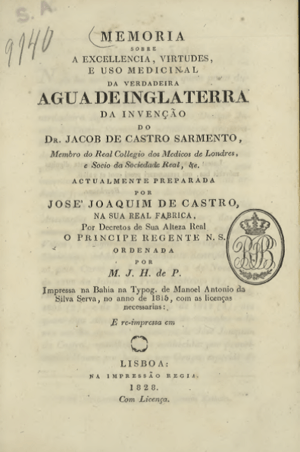Água de Inglaterra

Água de Inglaterra (“Water of England” or “English Water”) was an example of the 'secret remedies' that were in vogue in Portugal during the 18th Century. The name was used for various pharmaceutical preparations produced by several manufacturers from the end of the 17th Century to the beginning of the 19th. In addition to the name, these preparations had in common the fact that the major therapeutic ingredient was the bark of the cinchona tree, from which quinine is obtained. Reference to the drug can be found in all Portuguese Pharmacopeia between 1681 and 1821.[2][3][4]
History
Água de Inglaterra was used for the treatment of malaria, which at the time was endemic in several regions of Portugal. It was initially introduced from England in 1681 by Dr. Fernando Mendes, who “received a handsome gift from (King Pedro) on condition that he should reveal to him the secret of his composition and withhold it from the public”. However, the popularity of the mixture was short-lived, either because it did not perform as claimed or because of the sudden death of Mendes. The medicine, which was produced through an infusion of the cinchona bark in alcohol, was subsequently popularised in the 1730s by Jacob de Castro Sarmento, a doctor who was living in London, who set up a profitable distribution network for the product, which became one of the most widely used drugs in Portugal. Others, including Castro Sarmento’s nephew, produced their own counterfeit versions.[3] [5] The rights of the nephew's son in this regard were disputed in the Portuguese Parliament as late as 1821, having earlier been endorsed by the Prince Regent.[1]
With the isolation of quinine from the cinchona bark by Pelletier (1788-1842) and Caventou (1795-1877) it could be consumed as a salt. This resulted in Água de Inglaterra losing the importance it had had in the 18th Century. [2] A quinine-based product known as Água Inglesa (English Water) continues to be produced and sold in Brazil.
References
- 1 2 Paiva, Manuel Joaquim Henriques de. "Memoria sobre a excellencia, virtudes, e uso medicinal da verdadeira agua de Inglaterra". Biblioteca Nacional de Portugal. Retrieved 17 September 2018.
- 1 2 "Água de Inglaterra". Ciência em Portugal. Retrieved 16 September 2018.
- 1 2 D'Esaguy, Augusto (May 1936). "ÁGUA DE INGLATERRA". Bulletin of the Institute of the History of Medicine. 4 (5): 404-408. Retrieved 16 September 2018.
- ↑ Dias, José Pedro Sousa (2013). A água de Inglaterra : paludismo e terapêutica em Portugal no século XVIII. Caleidoscópio. p. 112. ISBN 9789896581824.
- ↑ Polónia, Amélia (2016). Ciência e Poder na primeira Idade Global (PDF). Faculdade de Letras da Universidade do Porto. p. 52-53. Retrieved 17 September 2018.